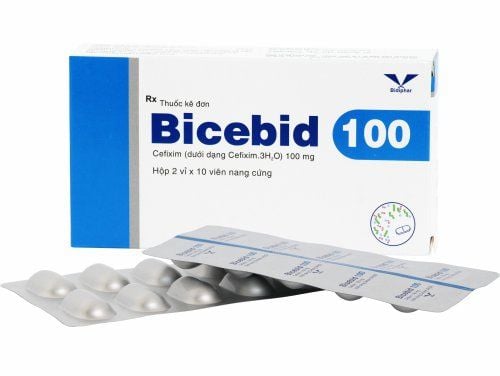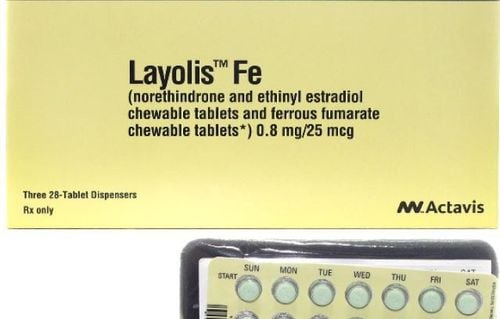This is an automatically translated article.
Zoramo is a bactericidal antibiotic that inhibits bacterial cell wall synthesis such as Benzylpenicillin. Medicines are used to treat parasites and fight infections. To ensure effective use of Zoramo, users need to follow the doctor's instructions.1. What is the use of Zoramo?
1.1. What is Zoramo? Zoramo belongs to the group of drugs that are antiparasitic, anti-infective, antiviral, and antifungal. Zoramo medicine has a drug Visa number-Registration number-SDK: VD-22158-15, this is a product manufactured by Ha Tay Pharmaceutical Joint Stock Company - VIETNAM.
Zoramo is made in the form of film-coated tablets, packed in a box containing 10 blisters, each blister of 10 pills.
Zoramo medicine has the main ingredients Amoxicillin (in the form of Amoxicillin trihydrate) 250mg and Cloxacilin (in the form of Cloxacilin sodium) 250mg.
1.2. What does Zoramo do? Zoramo is used to treat the following cases:
Infections in the upper respiratory tract. Lower respiratory tract infections caused by streptococcus, pneumococcus or non-penicillinase-producing staphylococci and H. influenzae. Uncomplicated urinary tract infections. Gonorrhea . Bile duct infection. Skin infections caused by streptococcus or staphylococcus, E. coli sensitive to amoxicillin. 1.3 Contraindicated to use Zoramo in case: People are sensitive to Penicillin and Cephalosporin antibiotics. Severe kidney disease.
2. Usage of Zoramo
2.1. How to take Zoramo Zoramo is a film-coated tablet that should be taken orally. Patients should take Zoramo tablets whole with a sufficient amount of filtered or boiled water. Take Zoramo 30 minutes before eating or 2 hours after eating. Patients do not arbitrarily add or reduce the recommended dose of Zoramo. It is necessary to apply the exact dose of Zoramo indicated on the package, the instruction sheet or instructions of the doctor or pharmacist. Users must not arbitrarily calculate, apply, or change the dose of Zoramo. 2.2. Dosage of the drug Zoramo Usual oral dose:
Use orally from 250mg to 500mg, once every 8 hours. Children up to 10 years old can be given a dose of 125 to 250mg, every 8 hours. Children under 20 kg usually receive a dose of 20 to 40 mg/kg body weight/day. Handling missed dose:
It is still best to take Zoramo at the time prescribed by your doctor. Usually, the patient can take the medicine 1 to 2 hours apart from the time ordered by the doctor. If you miss a dose of Zoramo, take it as soon as you remember, but if it is too close to the next dose, skip it. Do not make up or take a double dose of Zoramo.
Treatment of overdose:
Overdosage of Zoramo can cause vomiting or nausea, epigastric pain, diarrhea and rash. To treat Zoramo overdose, it is possible to reduce the absorption of the drug from the gastrointestinal tract by activated charcoal or induce vomiting in the patient. In some cases, it is necessary to apply gastric lavage.
3. Notes when using Zoramo
It is necessary to periodically check liver function, kidney function during long-term treatment with Zoramo. Patients with a history of allergy to penicillin or other allergens may experience a serious hypersensitivity reaction. The patient's history of allergy to penicillins or cephalosporins and other allergens should be thoroughly investigated before prescribing Zoramo. If an allergic reaction occurs, such as erythema, Quincke's edema, anaphylaxis, and Stevens-Johnson syndrome, the patient should discontinue amoxicillin therapy and immediately receive emergency treatment with adrenaline, oxygen, and corticosteroid therapy. intravenous administration and ventilation, including endotracheal intubation. The subjects that need to be noted before taking Zoramo include: Elderly, pregnant women, lactating women, children under 15 years old, people with liver failure, kidney failure, hypersensitivity. with any substance in the composition of the drug... Or subjects with myasthenia gravis, hepatic coma and stomach ulcers.
4. Side effects of the drug Zoramo
During the use of Zoramo, patients may still experience side effects such as:
Common, ADR more than 1/100: External rash (3 to 10%), usually appears slowly, after about 7 days after treatment. treat. Uncommon, 1/1000 less ADR less than 1/100: Vomiting/nausea, diarrhea, erythema, maculopapular rash, urticaria and Stevens-Johnson syndrome. Rarely, ADR less than 1/1000: Slight increase in SGOT, anxiety, agitation, irritability, confusion, insomnia, behavioral changes, dizziness, thrombocytopenia, anemia, thrombocytopenic purpura, and thrombocytopenia. eosinophilia, leukopenia, or agranulocytosis.
If these symptoms are encountered, the patient should stop using Zoramo and notify the doctor for appropriate treatment.
5. Zoramo drug interactions
Absorption Zoramo is not affected by food in the stomach, so it can be taken before, or after a meal. Nifedipine increases the absorption of Zoramo, the Amoxicillin component. Zoramo's risk of developing a rash, or hives, is increased when allopurinol is taken with it. Zoramo should not be used with thrombolytics, as it may increase the risk of major bleeding. Zoramo reduces the effectiveness of oral contraceptives and anticoagulants. To avoid interactions, before being prescribed Zoramo, the patient should inform the doctor about the drugs they are using, including dietary supplements. The doctor will base on that to prescribe the appropriate one.
6. How to store Zoramo
Zoramo medicine at room temperature, dry and cool, avoid direct exposure to sunlight. Zoramo should also not be left near places where there are devices that, when used, emit a higher temperature than room temperature such as: TVs, refrigerators, microwave ovens and stoves... The shelf life of Zoramo medicine is 36 months from the date of manufacture. Keep out of reach of small children and pets. Above is all information about Zoramo, patients need to carefully read the instructions for use, consult a doctor / pharmacist before using. Note, Zoramo is a drug prescribed by a specialist, patients absolutely cannot use it on their own.













